WORKED PROBLEMS
141
WORKED PROBLEMS
Problem 1
A series of two-
| Loci | Recombination frequency (%) | Loci | Recombination frequency (%) |
|---|---|---|---|
| a and b | 10 | c and d | 50 |
| a and c | 50 | c and e | 8 |
| a and d | 14 | c and f | 50 |
| a and e | 50 | c and g | 12 |
| a and f | 50 | d and e | 50 |
| a and g | 50 | d and f | 50 |
| b and c | 50 | d and g | 50 |
| b and d | 4 | e and f | 50 |
| b and e | 50 | e and g | 18 |
| b and f | 50 | f and g | 50 |
| b and g | 50 |
Solution Strategy
What information is required in your answer to the problem?
The linkage groups for the seven loci, the order of the loci within each linkage group, and the map distances between the loci.
What information is provided to solve the problem?
Recombination frequencies for each pair of loci.
For help with this problem, review:
Constructing a Genetic Map with Two-
Solution Steps
To work this problem, remember that 1% recombination equals 1 map unit. The recombination frequency between a and b is 10%; so these two loci are in the same linkage group, approximately 10 m.u. apart.
Hint: A recombination frequency of 50% means that genes at the two loci are assorting independently (located in different linkage groups).

The recombination frequency between a and c is 50%; so c must lie in a second linkage group.

The recombination frequency between a and d is 14%; so d is located in linkage group 1. Is locus d 14 m.u. to the right or to the left of gene a? If d is 14 m.u. to the left of a, then the b-to-
Hint: To determine whether locus d is to the right or the left of locus a, look at the b-to-
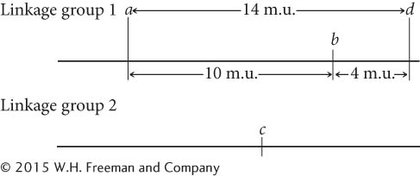
The recombination frequencies between each of loci a, b, and d and locus e are all 50%; so e is not in linkage group 1 with a, b, and d. The recombination frequency between e and c is 8%; so e is in linkage group 2:
142
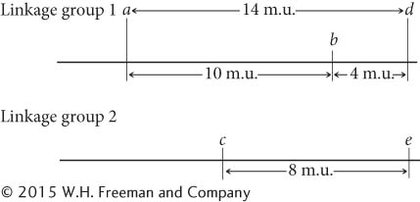
There is 50% recombination between f and all the other genes; so f must belong to a third linkage group:
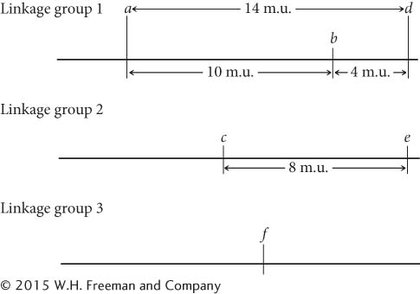
Finally, position locus g with respect to the other genes. The recombination frequencies between g and loci a, b, and d are all 50%; so g is not in linkage group 1. The recombination frequency between g and c is 12%; so g is a part of linkage group 2. To determine whether g is 12 m.u. to the right or left of c, consult the g–e recombination frequency. Because this recombination frequency is 18%, g must lie to the left of c:
Recall: Because some double crossovers may go undetected, the distance between two distant genes (such as g and e) may be less than the sum of shorter distances (such as g to c and c to e).
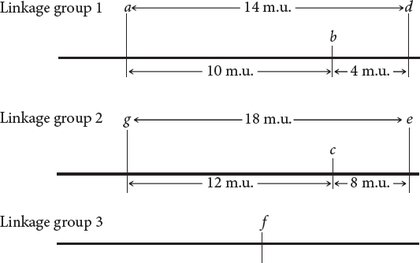
Note that the g-to-
Problem 2
Ebony body color (e), rough eyes (ro), and brevis bristles (bv) are three recessive mutations that occur in fruit flies. The loci for these mutations have been mapped and are separated by the following map distances:

The interference between these genes is 0.4.
A fly with ebony body, rough eyes, and brevis bristles is crossed with a fly that is homozygous for the wild-
Solution Strategy
What information is required in your answer to the problem?
The expected numbers of different phenotypes produced by the testcross.
What information is provided to solve the problem?
The map distances among the three loci.
The interference among the loci.
A testcross is carried out and 1800 progeny are produced.
For help with this problem, review:
Constructing a Genetic Map with a Three-
143
Solution Steps
The crosses are
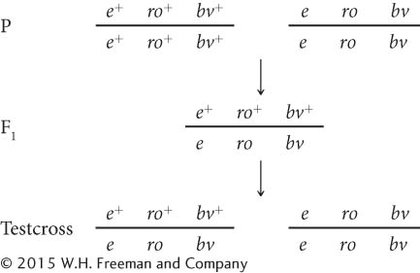
In this case, we know that ro is the middle locus because the genes have been mapped. Eight classes of progeny will be produced by this cross:
Hint: The order of the genes is provided by the genetic map.
| e+ | ro+ | bv+ | nonrecombinant | ||
| e | ro | bv | nonrecombinant | ||
| e+ | / | ro | bv | single crossover between e and ro | |
| e | / | ro+ | bv+ | single crossover between e and ro | |
| e+ | ro+ | / | bv | single crossover between ro and bv | |
| e | ro | / | bv+ | single crossover between ro and bv | |
| e+ | / | ro | / | bv+ | double crossover |
| e | / | ro+ | / | bv | double crossover |
To determine the numbers of each type, use the map distances, starting with the double crossovers. The expected number of double crossovers is equal to the product of the single-

However, there is some interference; so the observed number of double crossovers will be less than the expected. The interference is 1 – coefficient of coincidence; so the coefficient of coincidence is
coefficient of coincidence = 1 – interference
The interference is given as 0.4; so the coefficient of coincidence equals 1 − 0.4 = 0.6. Recall that the coefficient of coincidence is
Recall: The presence of interference means that not all expected double crossovers will be observed.

Rearranging this equation, we obtain:
number of observed double crossovers = coefficient of coincidence × number of expected double crossovers
number of observed double crossovers = 0.6 × 43.2 = 26
Hint: To obtain the number of single crossover progeny, subtract the number of double crossover progeny from the total number that resulted from recombination.
A total of 26 double crossovers should be observed. Because there are two classes of double crossovers (e+ ro bv+ and e ro+ bv), we expect to observe 13 of each class.
Next, we determine the number of single-
Hint: Don’t forget to subtract the double crossovers from the total number of recombinants.
Hint: The number of nonrecombinants can be obtained by subtraction.
The distance between ro and bv is 12 m.u.; so the number of progeny resulting from recombination between these two genes is 0.12 × 1800 = 216. Again, some of these recombinants will be single-
| e+ | ro+ | bv+ | 625 | nonrecombinant | ||
| e | ro | bv | 625 | nonrecombinant | ||
| e+ | / | ro | bv | 167 | single crossover between e and ro | |
| e | / | ro+ | bv+ | 167 | single crossover between e and ro | |
| e+ | ro+ | / | bv | 95 | single crossover between ro and bv | |
| e | ro | / | bv+ | 95 | single crossover between ro and bv | |
| e+ | / | ro | / | bv+ | 13 | double crossover |
| e | / | ro+ | / | bv | 13 | double crossover |
| Total | 1800 | |||||